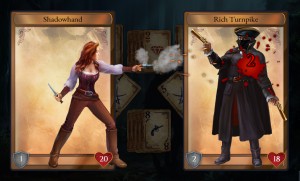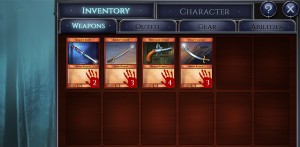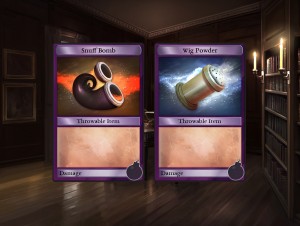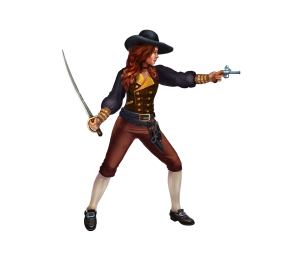Shadowhand Dev Diary #4: The Road to Rezzed
Wednesday, April 13th, 2016
The seed of the idea for Shadowhand came from our last game, Regency Solitaire, which was a historical solitaire game set in 1812. One of our older characters suggests that she may have had an exciting past.
What if we time traveled to her youth? Back then, highwaymen roamed the turnpike roads of England, robbing the wealthy. For Grey Alien Games’ story writer, Helen, the plot and characters swiftly followed.
Initially the project was conceived as a kind of prequel to Regency Solitaire, but as the project progressed it started to branch out in a new direction.
Dueling
Lead developer, Jake, had a flash of inspiration about the gameplay – thinking about titles like Puzzle Quest and Bookworm Adventures, along with the current popularity of turn-based card games, like Hearthstone and Card Crawl. What if we brought turn-based combat to solitaire?

We bandied around the idea of duels (of the pistols at dawn variety), and of making this a kind of duelitaire rather than solitaire. We also had ideas about dividing the game evenly between daytime (play as aristocrat) and night time (play as highwaywoman) scenes. Those ideas turned out to be rather clunky, but they helped to set us on the right track. We did a lot of design mockups to figure out what would look good, make sense, and offer the most entertainment value, without dramatically extending the scope of the game.
This helped us to decide that we would intersperse hands of solitaire with battles against an AI character. We already had a strong story, but were keen to include more RPG-like elements. The ideas started to fall into place. The game idea was one of a couple that we submitted to our publisher, Cliff Harris at Positech Games. He agreed to partner with us for the project, and so we also started to have more of his input and feedback on the game design direction.
More complexity
Our lead character – Lady Darkmoor by day, Shadowhand by night – started to come into focus. We started to work in earnest with our art team, and it became clear that we would need a lot more art than for our previous game.
Lady Darkmoor not only has a lot of clothing items and weapons – which affect gameplay and can be equipped as the player wishes – but also needs to be shown fighting in a number of poses with the selected clothing items in play. This not only changes the look of Lady Darkmoor, but also affects her combat stats.
There’s also an XP system that can be used to upgrade various abilities to help Lady Darkmoor gain an edge over her opponents. In addition, the game has a story mode which is at a higher resolution that our previous games, with large detailed characters. Versions of clothing and weapons also needed to work for this mode.
A tight deadline
It was still very early days (we had only been working on the project for a couple of weeks) when Positech offered us the chance to have a stand at EGX in September 2015. This gave us about a further 10 weeks to get a playable demo up and running, and also meant a major push to design a logo, box art and have a marketing package ready so we were able to make the most of the show.

Usually we would think about the marketing angle in more detail towards the end of the project, but EGX forced our hand and made us clarify our message and do a lot of market research. We had to be ruthless about what to include and what to leave out, so for example an inventory system that we thought was a pretty important facet of the game simply wasn’t joined up enough to include in the show demo. But many long hours and late nights on design and coding and some sterling work from the art team meant we had something to show – literally just in time for the show.
Meanwhile we were also working with a PR company to announce the game ahead of the show, which required considerable further work behind the scenes. This really paid off, because the game got a few mentions in well-known places ahead of the show, and we felt we were beginning to get the word out about the project.
Stand and deliver
Ready or not, we had to get out there and show our idea to the public. It was early enough in development that if it did not resonate with players for some reason, we could figure out why and totally change direction. But of course we were hoping that would not be the case.
To further our cause we wore costumes for the entirety of the event, with Helen doing her best to copy elements of Lady Darkmoor’s costume and Jake also getting in on the act as a highwayman.

At the last minute we were invited to talk about “surviving as an indie developer” on the Rezzed panel. This was a great opportunity to get noticed in our flamboyant costumes for a bit more PR, and apparently we gave out some useful tips as well. Giving out chocolate coins also proved a popular move – it may sound trivial, but thinking these things through for a well-planned stand can make a big difference to your experience of an event, and how memorable it is for visitors.
Show digest
The most valuable lessons from the show came from watching the public try out our demo, as well as from other developers. There was a spirit of camaraderie among developers at the show, and we were happy to share information and advice as well as to receive it. We got some great specific suggestions about game mechanics that fed into our prototyping, as well as some confirmation of assumptions we had already made by people playing.
The good news was that the solitaire mechanic is still challenging and addictive, and that turning it into a battle is just as fun or more fun, and is unique. From discussions with players we realised just how much they viewed the game through the “strategy” lens. The many other ideas we had yet to implement for the game should further reinforce this.
Further good news was that players loved the artwork and the theme. Regency Solitaire very much occupied a ‘casual’ space, as a relaxing card game about doing up a ballroom in the style of a Jane Austen romance. We wanted to keep some of the solid core ideas from that game but create a new game with a wider audience (targeting in particular players on Steam). Shadowhand then aims to be a bit more dark and edgy, with more of a suspenseful and adventuring plot and bringing in the new combat mechanics.

Fast forward – EGX-Rezzed in London
The latest show we attended was EGX in London at Tobacco Docks. The venue was great, and once again it was a good opportunity to cement relationships with other developers, the public and the press. The demo for this show was not much longer than the original one we cobbled together for the first EGX we attended in Birmingham, but this time many more elements are in place – both in terms of behind-the-scenes code and obvious elements such as artwork, UI and sound.
An RPG card game
We love playing RPGs and adding an inventory system with many usable and wearable items we feel is one of the strengths of Shadowhand. This latest EGX Rezzed event was a good opportunity to show off some of these elements to players and watch how they used them.

Some recent testing had helped us to make significant improvements to the tutorial, so again the show was a great opportunity to check that this was working well for players.
Feedback from the first EGX indicated that we were on-track to make a game that will work well on Steam, and it also taught us not to be shy about calling it a “solitaire-style” game. This core mechanic drives the game, is fun and addictive and it’s what we are good at.
Press coverage – Guardian, Eurogamer, RPS
Originally we called Shadowhand a card-battling adventure, but now we think that “RPG card game” is a more accurate description. This second EGX outing saw quite a few games press try out and write about the game. We were interested to see what they would call it and compare it to, among other things.
Both Keith Stuart and Jordan Erica Webber at the Guardian tried out the game, and picked it as one of their 12 favourite games of the event.
Eurogamer also mentioned Shadowhand as one of its top seven picks to visit while at the event. Editor Oli Walsh says the game blends “trademark soothing card-clearing gameplay with a versus mechanic, collectable skill cards, loot, and an 18th-century tale about the lawless adventures of a highwaywoman. Puzzle Quest is probably a more apt comparison than Hearthstone, but in any case Shadowhand is a real original, with an alluring and distinctive theme.” it turns out Oli is a major solitaire fan and said Shadowhand was likely to be “one of my top timesinks of 2016.”
Meanwhile Philippa Warr at Rock, Paper, Shotgun gave a detailed rundown of what to expect from the game, in her preview article ahead of the show.
Take away
Needless to say there has been considerable development and iteration since our first EGX outing. The opportunity to get feedback on an early build from players helped to crystallise the design, as well as giving us valuable insight from other devs.
That early demo was barely even a vertical slice (really a wafer thin one), so we had our work cut out to flesh out the game with more content and advanced battle mechanics.
Even though we work together as the couple that is the indie “Grey Alien Games” label, we have also worked with a large number of other people on this project: formally a publisher, logo designer, art team, musician, sfx team, voice over actress, and PR team; and informally, with a costume shop, public and press who tried the game, and friends and other devs who have offered support and advice.
Putting the game out there in such an embryonic state was a bit of a risk, but we think it paid off. We aim to launch this summer for PC and Mac on Steam.












